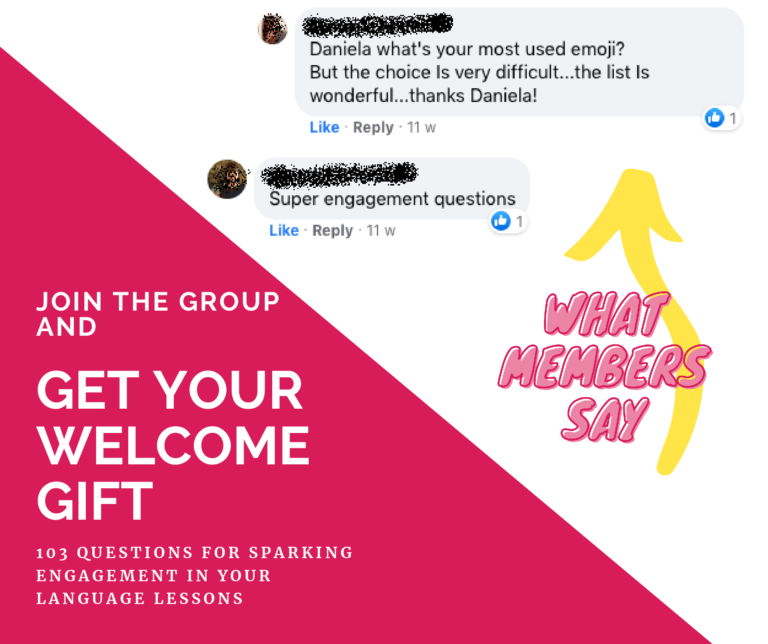
How to create English speaking environment in school? More general-wise, how to create language-rich environment in any language classroom? The first, basic step you can take is to use visual aids for speeding the acquisition process up and avoiding your students to feel overwhelmed.
Fear, frustration, shyness or lack of interest: there are so many reasons why students don’t speak the target language in the classroom. What to do, then?
There is one practical and pretty easy-to-implement strategy you can put into use right away. It’s about creating a safe, supportive and encouraging environment for taking all your students to get engaged with your speaking activities. This article is a step-by-step guide for the language teachers who want to build trust in the classroom by making the most out of visual aids.
The practical strategy I’m talking about is about using visual aids in the classroom. I know some language teachers might think:
“Really? That doesn’t sound very new to me!”.
I know it. Like many strategies you’ve probably been practising in your lessons, using visuals is one of those evergreen strategies that many teachers take for granted. Looking for the holy grail for getting the students to speak, they might miss the richness and effectiveness in the use of visual aids for language teaching.
I invite you to open up to an approach that trusts simple, easy-to-implement solutions which really unleash their potential if teachers are aware of the methodological principles that stand behind those strategies. Visual aids might actually be a solution you have given enough consideration so far, until you see the its potential in the way it affects the language acquisition process. Furthermore, the suggestopedic approach (my signature!) on the matter might trigger fresh ideas for your next lessons.
The questions I’m going to answer in this post are:
- Why using visuals?
- Feeding the peripheral perception, feeding the unconscious attention
- An invite to expand your current use of visuals: Suggestopedia and its approach to peripheral perception
- Help them to climb that wall: revision as part of memorisation
- What types of visuals?
- How to use visuals?
- Tips, guidelines, adaptations to help you with the implementation
This article is helpful for teachers searching for inspiration on:
- how to create English speaking environment in school
- how to create ANY LANGUAGE speaking environment
- how to create foreign and second language-rich environment in your classes, in school, in courses and online.
If you want to get additional tips and ideas on how to use visuals for language teaching, here is a brief guide you can download:
“They say the world has become too complex for simple answers. They are wrong.”
Ronald Reagan.
1. Why using visuals?
According to Suggestopedia, it is important that we create a language-rich speaking environment through abundance of visual stimuli (aids). This approach is very common throughout the majority of the language acquisition theories and pedagogies. By visual aids I mean: maps, charts, writings, signs, anything that can feed the students’ peripheral perception.
Why is using visuals is so important?
Because language teachers need to facilitate and support the acquisition process at any time. They can do that in many ways. The most simple one, though, is to provide the students with stimuli that relate to what we’ve been teaching and reinforce the new input. Think about speaking in the target language as a climbing wall. For the learners to be able to climb the wall, they need aids to get the grip on the wall and to get on top of it. If they don’t see any help, any hand holds to grasp, they’ll think it’s easier and safer to stay still on the ground!
By this analogy I mean, they might know the grammar and the vocabulary very well, but without some help in taking the first steps and keeping the focus on the new input, they might wobble when it comes to put the input into action.
What sets Suggestopedia apart from other language acquisition methods, as far as the visual aids is concerned, is the abundance of stimuli. In suggestopedic lessons we literally cover the classroom walls in visuals. As we introduce new input (be it vocabulary or grammar), we hang the related aids on the wall. The goal is to create abundance of stimuli which the students will catch both consciously and unconsciously.
Visuals work as stimuli feeding the students’ peripheral perception (i.e. unconscious attention). At the end of a lesson the students will be surrounded by visual stimuli reminding them the lexical units they have been learning.
Think about how we learned our mother tongue(s) when we were children. As children, we were surrounded by stimuli: family members and friends talking to us, tv, radio, songs, people talking on the street, signs of shops and places, etc. Almost anything or anybody that could send a message was a source of linguistic stimuli. We weren’t aware about that. Nevertheless, our brains absorbed, retained and learned to reuse those stimuli.
Therefore, the first goal of using visuals in the foreign/second language classroom is to recreate that context in order to enable the learners to experience a similar abundance, variety and richness of stimuli.
That is my first answer to the question how to create English speaking environment in school (and in ANY language classes, actually).
Another important point about why using visuals relates to the memorisation process.
As children, we learned our mother tongue by absorbing, copying, repeating, making attempts. It didn’t come all at once. Repeating was a key stage of the acquisition process. How long did it take you to phrase correctly “I want to play.”? It took time. And a good amount of repetitions, too!
Being able to look at the visuals any time will enable your students to revise the new input. Even though they don’t pay attention to the visuals, the stimuli are there and your students’ peripheral perception will catch them.
Memorisation is not a matter of comprehension: it is a far different process that requires consistent abundance of repetitions and revisions. By that, I don’t mean out-loud repetition of out-of-context lexical units. What I mean is that providing the students with the same input presented in many different ways.
For instance: they come across the verb “to get on with somebody” through a reading activity, a video-clip, through pictures describing the meaning of that verb, through a mind map collecting examples for the use of that verb within a variety of contexts, through structured exercises, through speaking exercises, as well.
2. What types of visuals?
A basic classification of the types of visual aids for teaching English as well as foreign/second languages includes:
- pictures
- realia
- charts and graphs
- conceptual maps, mind maps
- notes, examples
- videos (for online lessons)
- clusters (e.g.: opposites, synonyms, etc.)
I recommend John Hattie’s meta study Visible Learning (2009) if you want to learn about visuals.
3. How to use visuals?
In the guide you can download here below you’ll find some practical tips and guidelines on how to implement the peripheral perception suggestopedic principle. I did my best to keep it doable, even for teachers who are tied in the way they can use the classroom. Also, I added a few ideas for adapting the peripheral perception to online teaching. The guide is not only about how to create English speaking environment in school, I designed it for all language teachers, regardless of the languages they teach:
Want more support?
Join the Facebook group Independent Language Teachers Collective to get daily advice, tons of free training and to branch out with other independent language teachers like you!
ALSO…
Available only for the Collective members: free list 103 question for sparking engagement in your language lessons.
This is what members say about the freebie:

Join in the Collective and grab your welcome gift:
Join Facebook Group

